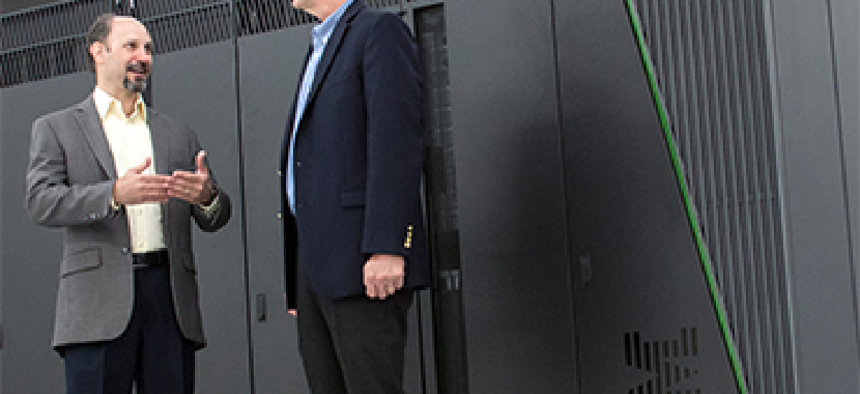Livermore has petaflops to share

One of the Energy Department's national laboratories is offering space in its supercomputer to industry and academia.

Fred Streitz, HPC Innovation Center director at the Lawrence Livemore National Lab, talks to Deputy Director Doug East. They are standing next to part of the Vulcan supercomputer. (LLNL photo)
Lawrence Livermore National Labs has five petaflops of computing power it wants to share. The research facility has officially opened up access to its massive Vulcan supercomputer to industry and academia for collaborative developmental projects with hopes of fueling technological innovation to spur U.S. economic competitiveness.
According to LLNL, the IBM Blue Gene/Q system Vulcan is operated by the labs’ High Performance Computing (HPC) Innovation Center. With five petaflops, equating to a quadrillion floating point operations per second, LLNL said Vulcan will serve collaborative lab-industry projects through the center as well as academic collaborations in support of DOE/National Nuclear Security Administration (NNSA) missions.
Last November, LLNL said Vulcan, equipped with 24 racks, 24,576 compute nodes and 393,216 compute cores, ranked as the world’s sixth fastest supercomputer. During its initial shakeout period, LLNL said Vulcan was combined with its larger Sequoia system, to produce set a world speed record of 504 billion events per second for a discrete event simulation in collaboration with the Rensselaer Polytechnic Institute. That achievement, said the lab, opens the way for the scientific exploration of complex, planetary-sized systems.
"High performance computing is a key to accelerating the technological innovation that underpins U.S. economic vitality and global competitiveness," said Fred Streitz, HPC Innovation Center director, in a June 11 statement. "Vulcan offers a level of computing that is transformational, enabling the design and execution of studies that were previously impossible, opening opportunities for new scientific discoveries and breakthrough results for American industries."
Industrial collaborations done under another LLNL project, called the hpc4energy incubator, were aimed at harnessing supercomputers to work on energy industry applications like smart grid, energy efficient buildings, liquid fuel consumption and carbon capture. That incubator program, begun in 2012, drew 30 letters of intent from industry, from which LLNL chose six.
Vulcan, it said will enable even larger computer simulations over longer periods of time with greater accuracy and resolution.
In addition to incubator programs, the lab said the HPC Innovation Center also provides on-demand, proprietary access to Vulcan and connects companies and academic collaborators with its computational scientists and engineers, and computer scientists to help solve high-impact problems across a broad range of scientific, technological and business fields.
As projects are initiated, LLNL said the HPC Innovation Center can rapidly bring together expert teams and identify computer systems needed to develop and deploy solutions for sponsoring companies.
NEXT STORY: Your essential catch-up of the week's news





